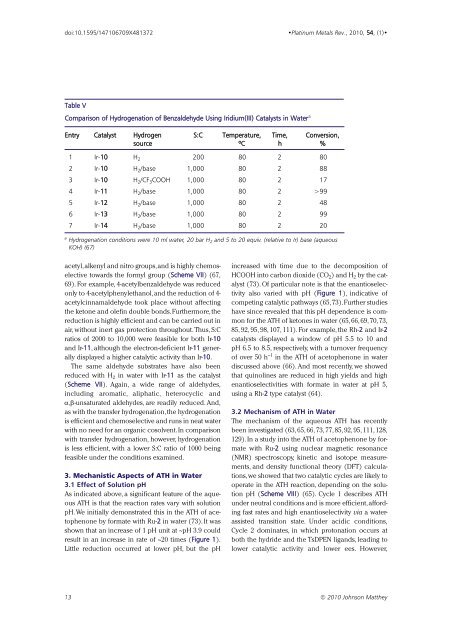Download Issue PDF - Platinum Metals Review
Download Issue PDF - Platinum Metals Review
Download Issue PDF - Platinum Metals Review
You also want an ePaper? Increase the reach of your titles
YUMPU automatically turns print PDFs into web optimized ePapers that Google loves.
doi:10.1595/147106709X481372<br />
•<strong>Platinum</strong> <strong>Metals</strong> Rev., 2010, 54, (1)•<br />
Table V<br />
Comparison of Hydrogenation of Benzaldehyde Using Iridium(III) Catalysts in Water a<br />
Entry Catalyst Hydrogen S:C Temperature, Time, Conversion,<br />
source ºC h %<br />
1 Ir-10 H 2 200 80 2 80<br />
2 Ir-10 H 2 /base 1,000 80 2 88<br />
3 Ir-10 H 2 /CF 3 COOH 1,000 80 2 17<br />
4 Ir-11 H 2 /base 1,000 80 2 >99<br />
5 Ir-12 H 2 /base 1,000 80 2 48<br />
6 Ir-13 H 2 /base 1,000 80 2 99<br />
7 Ir-14 H 2 /base 1,000 80 2 20<br />
a Hydrogenation conditions were 10 ml water, 20 bar H 2 and 5 to 20 equiv. (relative to Ir) base (aqueous<br />
KOH) (67)<br />
acetyl,alkenyl and nitro groups,and is highly chemoselective<br />
towards the formyl group (Scheme VII) (67,<br />
69). For example, 4-acetylbenzaldehyde was reduced<br />
only to 4-acetylphenylethanol,and the reduction of 4-<br />
acetylcinnamaldehyde took place without affecting<br />
the ketone and olefin double bonds.Furthermore,the<br />
reduction is highly efficient and can be carried out in<br />
air, without inert gas protection throughout.Thus, S:C<br />
ratios of 2000 to 10,000 were feasible for both Ir-10<br />
and Ir-11, although the electron-deficient Ir-11 generally<br />
displayed a higher catalytic activity than Ir-10.<br />
The same aldehyde substrates have also been<br />
reduced with H 2 in water with Ir-11 as the catalyst<br />
(Scheme VII). Again, a wide range of aldehydes,<br />
including aromatic, aliphatic, heterocyclic and<br />
α,β-unsaturated aldehydes, are readily reduced. And,<br />
as with the transfer hydrogenation,the hydrogenation<br />
is efficient and chemoselective and runs in neat water<br />
with no need for an organic cosolvent.In comparison<br />
with transfer hydrogenation, however, hydrogenation<br />
is less efficient, with a lower S:C ratio of 1000 being<br />
feasible under the conditions examined.<br />
3. Mechanistic Aspects of ATH in Water<br />
3.1 Effect of Solution pH<br />
As indicated above, a significant feature of the aqueous<br />
ATH is that the reaction rates vary with solution<br />
pH.We initially demonstrated this in the ATH of acetophenone<br />
by formate with Ru-2 in water (73). It was<br />
shown that an increase of 1 pH unit at ~pH 3.9 could<br />
result in an increase in rate of ~20 times (Figure 1).<br />
Little reduction occurred at lower pH, but the pH<br />
increased with time due to the decomposition of<br />
HCOOH into carbon dioxide (CO 2 ) and H 2 by the catalyst<br />
(73). Of particular note is that the enantioselectivity<br />
also varied with pH (Figure 1), indicative of<br />
competing catalytic pathways (65,73).Further studies<br />
have since revealed that this pH dependence is common<br />
for the ATH of ketones in water (65,66,69,70,73,<br />
85, 92, 95, 98, 107, 111). For example, the Rh-2 and Ir-2<br />
catalysts displayed a window of pH 5.5 to 10 and<br />
pH 6.5 to 8.5, respectively, with a turnover frequency<br />
of over 50 h –1 in the ATH of acetophenone in water<br />
discussed above (66). And most recently, we showed<br />
that quinolines are reduced in high yields and high<br />
enantioselectivities with formate in water at pH 5,<br />
using a Rh-2 type catalyst (64).<br />
3.2 Mechanism of ATH in Water<br />
The mechanism of the aqueous ATH has recently<br />
been investigated (63, 65, 66, 73, 77, 85, 92, 95, 111, 128,<br />
129). In a study into the ATH of acetophenone by formate<br />
with Ru-2 using nuclear magnetic resonance<br />
(NMR) spectroscopy, kinetic and isotope measurements,<br />
and density functional theory (DFT) calculations,we<br />
showed that two catalytic cycles are likely to<br />
operate in the ATH reaction, depending on the solution<br />
pH (Scheme VIII) (65). Cycle 1 describes ATH<br />
under neutral conditions and is more efficient,affording<br />
fast rates and high enantioselectivity via a waterassisted<br />
transition state. Under acidic conditions,<br />
Cycle 2 dominates, in which protonation occurs at<br />
both the hydride and the TsDPEN ligands, leading to<br />
lower catalytic activity and lower ees. However,<br />
13 © 2010 Johnson Matthey
















